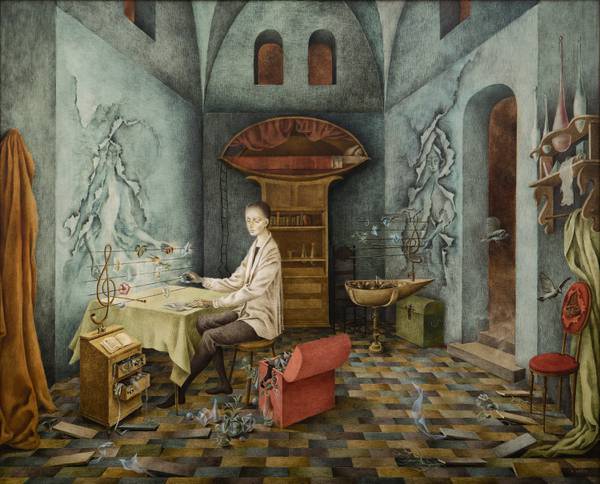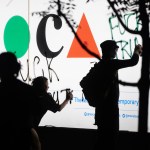You think you know Surrealism, then you visit an exhibition dedicated to a Surrealist artist you’ve never even heard of. You think you’ve seen a painting fully, then you look again and again, each time noticing elements you missed in previous rounds. You think you understand the world that surrounds you, only to have its infinite intangibility made momentarily clear.
The pleasures of chance encounters, of mystery and unknowing, were highly esteemed by the group of artists known as the Surrealists, founded in Paris in 1924 by André Breton, and proudly well represented at the Art Institute of Chicago in its permanent collection. Indeed, one of the museum’s most beguiling galleries, dark and spotlit, houses dozens of strange little treasure boxes constructed by Joseph Cornell; exquisite corpses playfully drawn by Man Ray and friends; wittily contradictory paintings by René Magritte; and of course, the drippy erotic dreamscapes of Salvador Dali. But nowhere at the AIC could one ever find an artwork by Remedios Varo, until now.
Who?
Exactly. Unless you’re a specialist in women of the Surrealist movement, you — like me — are probably unfamiliar with Varo, who was only 54 when she died of a heart attack at her home in the Roma neighborhood of Mexico City. It was 1963, the height of her career. Since then, she has had a cult following in Mexico, where most of her work is held, but she has been too little known outside of the country, a situation slowly changing with her inclusion in the 2022 Venice Biennale, recent acquisitions by New York’s Museum of Modern Art, the Toledo Museum of Art and the Museum of Fine Arts Boston, and now “Remedios Varo: Science Fictions,” a survey of her final period, on view at the AIC through the end of November.
Born in 1908 in a small Catalonian town, María de los Remedios Alicia y Rodriga Varo y Uranga’s father was an Esperanto-speaking hydraulics engineer who encouraged her interest in technical drawing, mineralogy and museums. She grew up and went to art school in Madrid, eventually relocating to Barcelona, where she made a living doing commercial work for advertising firms and joined the avant-garde art scene, showing work in Logicofobistas, one of the most influential Spanish Surrealist exhibitions. When the Spanish Civil War broke out, she escaped to Paris and into the innermost circle of French Surrealism, only to flee again as World War II escalated. By 1942 she was making a new home in Mexico City amid a close community of European refugee artists and intellectuals, among them painter Leonora Carrington and photojournalist Kati Horna, who would become lifelong friends.
The core of “Remedios Varo: Science Fictions” are 21 variously-sized oil paintings made between 1955 and 1963. They are astonishing. They are also marvelously hard to place in time, enriched with the detail, architecture and comedy of Renaissance allegorical scenes; illuminated with the precious materials and arcana of Medieval manuscripts; painted using chance techniques favored by the Surrealists; and illustrating narratives, characters and philosophies inspired by, and sometimes satirically critical of, contemporary scientific research, the occult theories of Russian-Armenian mystic George Gurdjieff, and much in between. To look at her pictures, over and over again, is to be drawn into a marvelously other realm that, for all its odd technology and magical happenings and unusual landscapes, is peopled by beings who could almost be us, and who have much to reveal about the invisible workings of our world and our potential to change it.
Varo’s technical prowess is part of the allure. How does she create the impossibly fine white strokes of the pulleys, turbines, funnels, rays, hairs and strings that reappear throughout her paintings? The lines often mark elements through which energy is being transferred, sometimes invisibly, sometimes magically. They compose the beams of starlight that pass through the prism held by an owl-lady alchemist and which help bring to life the birds she sketches, a profound testament to the power of creativity. Likewise, they concretize the tunes played by enlightened musicians, sounds capable of stimulating human flight and building an octagonal tower out of fossils. They trace the entirety of the wind-driven mechanical system that powers the wheeled coat-house worn by the shaggy-haired subject of “Vagabond,” an itinerant traveler burdened like so many émigrés by the trappings of home. To do all of this, Varo borrowed the technique of sgraffito from ceramics, most likely using sewing needles to scratch through the painted surface to reveal contrasting white gesso below.
The terrifically informative catalog, edited by Caitlin Haskell of the AIC and Tere Arcq, formerly of the Museo de Arte Moderno in Mexico City, who jointly curated the show, includes an inspired section explaining the vast array of techniques Varo employed. Would that more art books did this, either based on interviews with living artists or, as here, advanced technology like portable microscopes and high-resolution photography.
Some of her methods will be familiar to anyone who has taken a painting or drawing class, others less so. Varo meticulously planned out her compositions in full-scale drawings called cartoons, a few of which are on display, then transferred them to prepared panels, an explanation that harmonizes with the exacting geometry visible in such works as “The Alchemist.” There, inside a garret, a scientist concocts an elixir of life out of the natural atmosphere, but the room’s checkered floor is also a garment she is wearing that has merged seamlessly with her scalp, somewhere between a prison and the cycle of life.
Varo also employed decalcomania, pressing a material like glass or paper against a freshly painted surface then removing it, causing a suction that produced a biomorphic texture. The Surrealists favored this method for its unpredictability; Varo used it in a highly controlled manner to achieve otherworldly yet believable landscapes, like the eerie mangroves explored by boat in “Discovery” and the craggy cliffs into which the protagonist of “The Flautist” leans. Behind those rocks stand a range of exploded volcanoes beneath a misty night sky, their nebulous effect achieved via soufflage, in which air blown through a straw bubbles and splatters thinned paint around the canvas, recalling pictures of the cosmos found in Varo’s library and archive. A selection of such items, from books to crystals, are on view.
With only a tiny handful of Varo’s artworks owned by public collections in this country, none of them located in Chicago, this show is unmissable. It is also, shockingly, the AIC’s first solo exhibition dedicated to a woman Surrealist painter or to a woman artist working in Mexico. May it be the first of many.
“Remedios Varo: Science Fictions” runs through Nov. 27 at the Art Institute, 111 S. Michigan Avenue; more information at 312-443-3600 and artic.edu
Lori Waxman is a freelance critic.
This post was originally published on this site be sure to check out more of their content.








Wow Thanks for this posting i find it hard to see good resources out there when it comes to this content appreciate for the article website